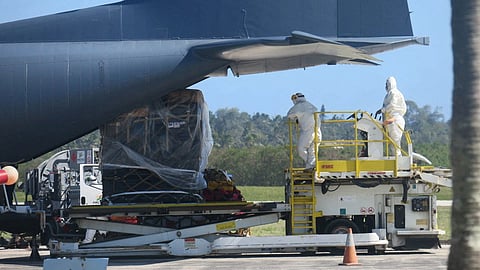

The first aircraft carrying humanitarian supplies arrived in Tonga on Thursday, five days after the South Pacific island nation was hit by a volcanic eruption and tsunami that devastated communities and spoiled most of its drinking water.
A Royal New Zealand Air Force C-130 Hercules landed in Tonga's Fua'amotu International Airport, a defence spokesperson said, after a blanket of volcanic ash was cleared off the runway.
An Australian Globemaster military transport aircraft also landed.
"The C-17A flight today was made possible thanks to the tireless efforts of Tongan authorities who have worked to clear a thick layer of volcanic ash from the runway," Australian Defence Minister Peter Dutton said in a statement.
Dutton said the aircraft was loaded with supplies including water desalination equipment, shelter, kitchens, and a sweeper to help remove ash from the airport. A second Australian aircraft was due to make the flight on Thursday.
The New Zealand aircraft was carrying humanitarian aid and disaster relief supplies, including kits for temporary shelters, generators, hygiene and family kits, and communications equipment, Foreign Minister Nanaia Mahuta said in a statement.
The delivery of the supplies brought in by both aircraft was contactless to ensure Tonga remains free of the coronavirus.
The Hunga Tonga-Hunga Ha'apai volcano erupted with a deafening explosion on Saturday, sending tsunami waves rolling across the archipelago that killed at least three people and destroyed villages, resorts and many buildings and knocked out communications for the nation of about 105,000 people.
Rachael Moore, Australia's high commissioner to Tonga, said the loss of property had been "catastrophic".
"Along the western beaches there is a moonscape where once beautiful resorts and many, many homes stood," Moore told Australian radio, adding that drinking water was "an extremely high priority".
Telephone links between Tonga and the outside world were reconnected late on Wednesday, though restoring full internet services was likely to take a month or more, according to the owner of the archipelago's sole subsea communications cable.
Speaking to Reuters from the capital, Nuku'alofa, journalist Marian Kupu said Tongans were cleaning up all the dust from the volcanic eruption but feared they may run out of drinking water.
"Each home has their own tanks of water supply but most of them are filled with dust so it's not safe for drinking," Kupu said.
The first of two New Zealand navy ships also arrived on Thursday, its High Commission said. It will check shipping channels and wharf approaches at Tonga's port in preparation for the arrival on Friday of the second ship carrying aid including 250,000 litres of water and desalination equipment that will be able to produce 70,000 litres a day.
An Australian ship is due to set sail on Friday.
Tongans abroad were frantically calling families back home to ensure they are safe.
"It was very relieving to hear from them," said Fatafehi Fakafanua, the speaker of Tonga's legislative assembly, who was in New Zealand when the disaster struck, after making contact with his family.
"They are fine ... The government has advised them to drink bottled water, to cover up when they are outside and also wear masks because of the ash."
The United Nations said that about 84,000 people – more than 80% of the population - has been badly affected by the disaster with safe water being "the biggest life‑saving issue".
The Hunga Tonga-Hunga Ha'apai volcano erupted about 40 miles (65 km) from the Tongan capital with a blast heard 2,300 km (1,400 miles) away in New Zealand.
Waves reaching up to 15 metres (49 feet) hit the outer Ha'apai island group, destroying all the houses on the island of Mango, as well as the west coast of Tonga's main island, Tongatapu, where 56 houses were destroyed or seriously damaged.
Accounts of miraculous escapes are emerging including that of a 57-year-old being hailed as a "real life Aquaman" after recounting how he had to swim at sea for about 27 hours after being swept away by the tsunami.